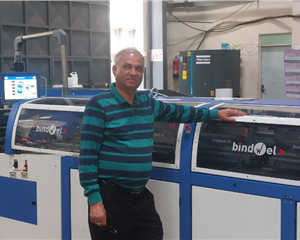Madhur Bhatia, head, operations, Pearson India Education Services, in a conversation with Subhasis Ganguli explains how the company’s inventory planning has improved over years as it worked towards bringing the culture of offering better services and experiences to its customers
Congratulations on your new responsibilities. It’s a huge role. What are the basic differences between your current role and the previous one?
Thank you. I have been managing the operations for Pearson India. With the new set of responsibilities, my portfolio include customer service, facilities and corporate travel management. I need to make sure that our organisation has the most suitable working environment for its employees and focus on using best business practices to improve efficiency, by reducing operating costs while increasing productivity.
As you are also responsible for stock now, does it affect your print decisions?
No. Our print runs have been increasing year on year. However, decisions regarding print run and demand are subject to mutual agreement and approvals during our monthly meetings.
As the head of operations, you are now responsible for the whole value chain. What are you doing to improve the efficacy of the system?
One of our key areas of focus would be on customer experience — managing end-to-end customer engagement and bringing out business recommendations, design processes and improvements that lead to customer delight. As a company, we collaborate with our customers to ensure that our products and services deliver on their intended outcomes.
You are now a part of a global team. Where do you place Indian printers vis-à-vis printers in other countries?
India is one of the fastest growing markets in the world for printing. In the last few years, we have seen incredible advancement in the quality, service and technology offered by Indian printers. This is definitely going to be the game-changer in the future for the publishing industry.
In your opinion, what do Indian printers lack on their way to becoming a preferred print destination for international publishers? Which are the areas they need to improve?
There is already a lot of business happening with international publishers. However, I believe in the future every single industry, including education, will be revolutionised by digitisation. Therefore, it is important to be open to learning and acquiring newer technologies for the future.
With your new position, how could you help Indian printers go global? What are your expectations for them?
We are closely working with our colleagues in different geographies. At Pearson, our mission is to help learners make progress in their lives by providing them high-quality content and resources. Printers are important partners for us in delivering this.
About Pearson India
Founded in 1844, Pearson has 35,000 employees across 70 countries worldwide. Its expertise includes educational courseware and assessment, and a range of teaching and learning services powered by technology. Its mission is to help people make progress through access to better learning. Pearson believes that learning opens opportunities, creating fulfilling careers and better lives.
Pearson’s unique insight and world-class expertise comes from its long history of working closely with teachers, learners, researchers, authors, and thought leaders. Its products and services are used by millions of teachers and learners around the world every day.
Pearson is organised around three key stages of learning — K12; higher education and test preparation and vocational and professional education.
Established in India in 1998, Pearson has introduced its wide range of products and services in educational institutes as well as directly to the learners.
What is your take on GST? The general feel is that cost is going up…
We are aligned with other publishers and printers on GST.
What has been your experience post-GST?
We are yet to see and evaluate the overall impact of GST. At present, we are seeking more clarity on the subject.
As head of operations, you are now responsible for stock holding as well as cash flow. So, you need to print the stock just-in-time at the same time keep a control on print quantity to reduce wastage and pulping. What is your plan to mitigate these challenges?
As I mentioned, we need to learn from the past and work towards bringing the culture of offering better services and experiences to our customers. Our inventory planning has been improving over the past years and frequent meetings have helped in taking the right decisions on print demand.
Do you think digital printing could help overcome these challenges?
Both offset and digital are useful printing methods. Each has particular benefits depending on a project’s requirement. For small print runs and quick turnarounds, digital printing is extremely useful.
There is no colour inkjet print engine in India. Do you think there is enough market for the same? Is it the right time to invest in the technology?
It will take some time to generate business for colour inkjet. There is a scope of commercial printing with inkjet printing but that requirement is shrinking.
Do you feel the need for a common forum, where you could meet periodically, share your knowledge and discuss challenges in a less formal environment?
Absolutely, there is a need to have a common platform wherein all stakeholders can come under one roof and discuss ideas, knowledge and share best practices in the industry. I have been attending these in the past and will be delighted to see more of these avenues created.
Will you be ready to attend such a forum organised by a third party? What is your take on this?
As a global company, there are a few guidelines and we will need approvals from the internal stakeholders.
You are one of the market leaders using PUR binding on regular basis. What has been your experience with PUR?
We believe PUR is one of the most durable bookbinding glue available. We have been using it for a while now and have not faced any issues after sale. For us, quality and durability of our products is of utmost importance and PUR helps us achieve that.
Today, no publishing house has a laboratory of its own to test the end-product. With the change in the market and as awareness and expectation of the end-customer is growing, isn’t it important to have a lab to test the quality before the stocks hit the market?
Pearson products help meet learner needs and deliver measurable results that transform lives all over the world. We are focused on providing an engaging, interactive learning experience for better academic achievement. Content is core to our business. Pearson’s long-trusted content is authored by respected educators and practitioners from across the entire higher education spectrum. These are now delivered in blended formats depending on students and course requirements. We have partnered with one of the best printers to ensure that we offer high quality products and services.
Though the onus is on the printer to deliver the right quality, it is important to specify your requirements correctly…
We deliver expert educational courseware for learners, and teaching and learning services to the institutes. Our strength is content and we will continue to work with our print partners to drive high-quality products and services.
About Madhur Bhatia
A BFA (Bachelor of Fine Arts) from College of Art, New Delhi, Madhur Bhatia joined Pearson in 2003 as a designer. Today, he is responsible for designing of the books, covers, marketing material, book manufacturing, procurement, property and facilities, customer service, travel and events, health and safety, supply chain and logistics.
Prior to Pearson, he was in Dabur India as senior visualiser in its in-house print and media agency. During this time, Bhatia also worked with many advertising agencies in part time or freelance capacities and has designed packaging of many big brands.















 See All
See All